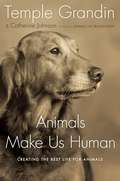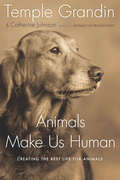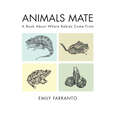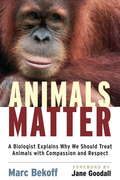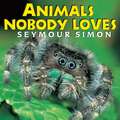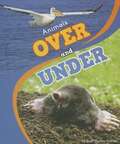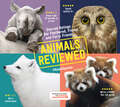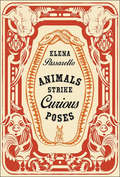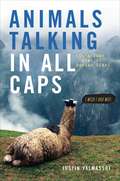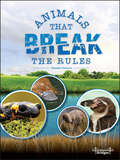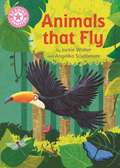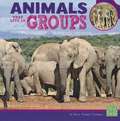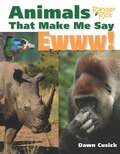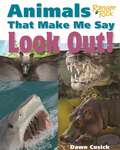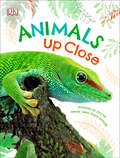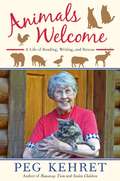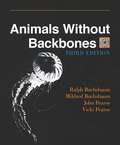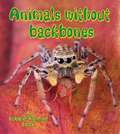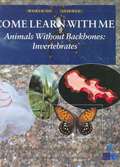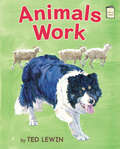- Table View
- List View
Animals Make Us Human: Creating the Best Life for Animals
by Catherine Johnson Temple Grandin"Can a dog be happy if you have to leave him alone for most of the day? Is the lion that paces all day in the zoo miserable or just exercising? Should you train your cat? Why do gerbils dig so much? How can we keep our animals from panicking at the vet's? Drawing on almost thirty years of research, experimentation, and experience, Temple Grandin answers these and countless other questions by focusing on the emotional needs all animals share. Animals have feelings, she argues, and we need to stimulate their positive emotions - seeking and play - while ensuring that they're free from the negative ones - fear, panic, and rage - if they're going to have a truly good life. With stories and practical insights, Grandin explains how to fulfill the specific needs of dogs, cats, horses, wildlife, and farm and zoo animals, and lets us see happiness through the eyes of our animals."--BOOK JACKET.
Animals Make Us Human: Creating the Best Life for Animals
by Catherine Johnson Temple GrandinHow can we give animals the best life-- for them? What does an animal need to be happy? In her groundbreaking, best-selling book Animals in Translation, Temple Grandin drew on her own experience with autism as well as her experience as an animal scientist to deliver extraordinary insights into how animals think, act, and feel. Now she builds on those insights to show us how to give our animals the best and happiest life-- on their terms, not ours. Knowing what causes animals physical pain is usually easy, but pinpointing emotional distress is much harder. Drawing on the latest research and her own work, Grandin identifies the core emotional needs of animals and then explains how to fulfill the specific needs of dogs and cats, horses, farm animals, zoo animals, and even wildlife. Whether it's how to make the healthiest environment for the dog you must leave alone most of the day, how to keep pigs from being bored, or how to know if the lion pacing in the zoo is miserable or just exercising, Grandin teaches us to challenge our assumptions about animal contentment and honor our bond with our fellow creatures.Animals Make Us Human is the culmination of almost thirty years of research, experimentation, and experience. This is essential reading for anyone who's ever owned, cared for, or simply cared about an animal.
Animals Mate: A Book About Where Babies Come From
by Emily Farranto"Where do babies come from?" It's a question every child asks eventually, and Animals Mate is the simple, straightforward, and developmentally appropriate guide every parent needs to normalize sexual reproduction via adorable animal partners. With a modern design and beautiful illustrations, Animals Mate introduces facts about mating, including tactful discussion of the mechanics of the process, anatomy, and sperm and eggs. Bypass the awkwardness that often accompanies "the talk" about how babies are made and help your child understand sex and reproduction as the natural and wonderful process that results in the world's greatest treasure: babies!
Animals Matter: A Biologist Explains Why We Should Treat Animals with Compassion and Respect
by Marc Bekoff Jane GoodallNonhuman animals have many of the same feelings we do. They get hurt, they suffer, they are happy, and they take care of each other. Marc Bekoff, a renowned biologist specializing in animal minds and emotions, guides readers from high school age up--including older adults who want a basic introduction to the topic--in looking at scientific research, philosophical ideas, and humane values that argue for the ethical and compassionate treatment of animals. Citing the latest scientific studies and tackling controversies with conviction, he zeroes in on the important questions, inviting reader participation with "thought experiments" and ideas for action. Among the questions considered: * Are some species more valuable or more important than others? * Do some animals feel pain and suffering and not others? * Do animals feel emotions? * Should endangered animals be reintroduced to places where they originally lived? * Should animals be kept in captivity? * Are there alternatives to using animals for food, clothing, cosmetic testing, and dissection in the science classroom? * What can we learn by imagining what it feels like to be a dog or a cat or a mouse or an ant? * What can we do to make a difference in animals' quality of life?Bekoff urges us not only to understand and protect animals--especially those whose help we want for our research and other human needs--but to love and respect them as our fellow beings on this planet that we all want to share in peace.
Animals Nobody Loves
by Seymour SimonIn 26 giant photographs--of a roaring grizzly, a piranhas razor-sharp teeth, a rattlesnakes poisonous fangs--Seymour Simon reveals the truth about natures most misunderstood animals and lets the reader decide what to really think about natures grossest, fiercest, and most fascinating survivors.
Animals Over and Under (Animal Antonyms Series)
by Beth Bence ReinkeThis book introduces the child to animals in their habitat of sky, ground, underground and underwater.
Animals Reviewed: Starred Ratings of Our Feathered, Finned, and Furry Friends
by Association of Zoos and AquariumsAre you ready to #RateASpecies? Zoos and aquariums have poked wild fun at their animal friends—and their “product reviews” will leave your pack howling! Packed with adorable animal photos and laced with wit and humor, Animals Reviewed is a must-read for animal lovers of all ages. Proceeds benefit the Association of Zoos and Aquarium’s mission to advance animal welfare, public engagement, and conservation.
Animals Strike Curious Poses
by Elena Passarello“It might be the best book on animals I’ve ever read. It's also the only one that's made me laugh out loud.” —Helen Macdonald, The New York Times Book Review Beginning with Yuka, a 39,000-year-old mummified woolly mammoth recently found in the Siberian permafrost, each of the sixteen essays in Animals Strike Curious Poses investigates a different famous animal named and immortalized by humans. Modeled loosely after a medieval bestiary, these witty, playful, whip-smart essays, from a winner of a Whiting Award for nonfiction, traverse history, myth, science, and more, bringing each beast vibrantly to life. “Stunning . . . Passarello’s keen wit is on display throughout as she raises questions about the uniqueness of humans. . . . A feast of surprising juxtapositions and gorgeous prose.” —Publishers Weekly (starred review) “I’ve spent decades reading books on the roles animals play in human cultures, but none have ever made me think, and feel, as much as this one. It’s a devastating meditation on our relationship to the natural world.” —Helen Macdonald, The New York Times Book Review
Animals Talking in All Caps: It's Just What It Sounds Like
by Justin ValmassoiA goat who wants to sell you some meth. A giraffe who might be violating his restraining order. An alpaca with a very dirty secret. A cat who's really mad at you for cancelling Netflix instant. These are just a few of the hilariously human animals you'll meet in Animals Talking in All Caps. Inspired by the wildly popular blog of the same name and including some of the site's best-loved entries as well as gobs of never-before-seen material, these pages provide a brilliantly unhinged glimpse into the animal mind.
Animals That Break the Rules (Nature's Rule Breakers)
by VizcarraDid you know there are critters that are powered by the sun, mammals that lay eggs, and penguins with pink poop? What are these rule-breaking animals? Why do they do what they do? Be a critter detective and find out by digging into this Animals That Break the Rules Animal Book! Part of the Nature’s Rule Breaker’s Children’s Book Series, this 32-page nonfiction book explores strange animal species that are fascinating and fun with fun-filled facts and vibrant photos that will prove just how unique these animals really are!Science Books for Kids Ages 8-12 Features:Comprehension questionsExtension activitySupports NGSS standardsAbout Rourke Educational Media:We proudly publish respectful and relevant nonfiction and fiction titles that represent our diverse readers, and are designed to support reading on a level that has no limits!
Animals That Burrow
by Marilyn Woolley Keith PigdonMany animals shelter and raise their young in burrows. Some spend a great deal of time in their burrows.
Animals That Fly: Independent Reading Pink 1B Non-fiction (Reading Champion #515)
by Jackie WalterThis non-fiction text explores different animals that fly. The book is part of Reading Champion, a series carefully linked to book bands to encourage independent reading skills, developed with Dr Sue Bodman and Glen Franklin of UCL Institute of Education (IOE)Reading Champion offers independent reading books for children to practise and reinforce their developing reading skills.Fantastic, original stories are accompanied by engaging artwork and a reading activity. Each book has been carefully graded so that it can be matched to a child's reading ability, encouraging reading for pleasure.Perfect reads for children aged 4-5, reading at book band pink.
Animals That Hibernate
by Larry Dane BrimnerA survey of true and light-sleeping hibernators--what happens to their body processes, how they prepare for their long sleeps, and what they do when they awaken. Named to the Science Books and Films "Best Children's Science Book List, 1991". Defines hibernation and describes different animals' ways of preparing for and spending the winter. Includes bibliographical references and index.
Animals That Live In Groups
by Bernd Heinrich Kelsi Turner TjernagelWhy do millions of flamingoes flock together in Africa? Why do meerkats live in colonies? Animal groups have some fascinating behaviors. Discover the amazing bonds that keep animal groups together.
Animals That Live Under the Ground (Into Reading, Level I #61)
by Debbie CroftNIMAC-sourced textbook
Animals That Make Me Say Ewww! (Animals That Make Me Say...)
by Dawn CusickThat&’s so gross! Prepare to be grossed out by an engaging and unique look at some of the more disgusting survival techniques from the animal kingdom. From blood-squirting reptiles to blood-sweating mammals to nose-picking primates, learn about some of the most disgusting creatures in the animal kingdom. Author Dawn Cusick and the National Wildlife Federation compile a volume as attractive as its subject is disgusting.
Animals That Make Me Say Look Out! (Animals That Make Me Say...)
by Dawn CusickHey! Look out! Sharp-eyed readers will need to keep their eyes peeled in this engaging look at how animals of all shapes and sizes blend in and survive in their native ecosystems. How do animals deal with danger? From crocodiles standing on their tails to great white sharks with their jaws wide open to well-camouflaged venomous snakes, prospective naturalists and conservationists will have a lot to look out for in this exploration of dynamic ecosystems and the animals that hide and hunt in them. Back matter includes glossary, curated reading list and a scavenger hunt.
Animals Up Close: Animals as you've Never Seen them Before (DK Look Closer)
by DKGet closer to your favorite animals through amazing nature photographySee the world's most fascinating animals closer and more vividly than you've ever seen before, through stunning, larger-than-life photography in this modern DK classic.Young readers will be fascinated by stories such as the crab that carries its home on its back, or the salamander that turns from a fish into an amphibian as it grows. They will be absorbed by the incredible detail showcased in these amazing images, from the fine structure of bird's feathers to the neon green scales of a gecko. Fun, flowing text delivers in-depth information about life in different habitats and how animals have adapted to thrive in these places.Innovative, contemporary design and DK's characteristically reliable and interesting information combine in Animals Up Close to create the perfect nature book for children.
Animals Welcome: A Life of Reading, Writing, and Rescue
by Peg KehretA moving memoir from an award-winning authorA mother cat and her kittens, shot with a pellet gun. A poacher illegally stalking a bear. Peg Kehret tells these true stories and more as she invites readers into her life on a small wildlife sanctuary. Vividly showing the joys of animal rescue while providing facts about the animals and birds she encounters, Kehret also shares the tragedy of her husband's sudden death, and the pain of losing Pete, the shelter cat who co-authored three of her books. Written with honesty, heart, and humor, Animals Welcome is a personal glimpse into the life of an author who loves animals, and the philosophy by which she lives. .
Animals Without Backbones
by John Pearse Ralph Buchsbaum Mildred Buchsbaum Vicki PearseAnimals Without Backbones has been considered a classic among biology textbooks since it was first published to great acclaim in 1938. It was the first biology textbook ever reviewed by Time and was also featured with illustrations in Life. Harvard, Stanford, the University of Chicago, and more than eighty other colleges and universities adopted it for use in courses. Since then, its clear explanations and ample illustrations have continued to introduce hundreds of thousands of students and general readers around the world to jellyfishes, corals, flatworms, squids, starfishes, spiders, grasshoppers, and the other invertebrates that make up ninety-seven percent of the animal kingdom. This new edition has been completely rewritten and redesigned, but it retains the same clarity and careful scholarship that have earned this book its continuing readership for half a century. It is even more lavishly illustrated than earlier editions, incorporating many new drawings and photographs. Informative, concise legends that form an integral part of the text accompany the illustrations. The text has been updated to include findings from recent research. Eschewing pure morphology, the authors use each group of animals to introduce one or more biological principles. In recent decades, courses and texts on invertebrate zoology at many universities have been available only for advanced biology majors specializing in this area. The Third Edition of Animals Without Backbones remains an ideal introduction to invertebrates for lower-level biology majors, nonmajors, students in paleontology and other related fields, junior college and advanced high school students, and the general reader who pursues the rewarding study of the natural world.
Animals Without Backbones (Big Science Ideas)
by Bobbie KalmanDescribes the different kinds of invertebrates and how they function without backbones, including sponges, worms, squids, crustaceans, insects, and spiders.
Animals Without Backbones: An Introduction to the Invertebrates (New Plan Texts at the University of Chicago)
by John Pearse Ralph Buchsbaum Mildred Buchsbaum Mildredd BuchsbaumAnimals Without Backbones has been considered a classic among biology textbooks since it was first published to great acclaim in 1938. It was the first biology textbook ever reviewed by Time and was also featured with illustrations in Life. Harvard, Stanford, the University of Chicago, and more than eighty other colleges and universities adopted it for use in courses. Since then, its clear explanations and ample illustrations have continued to introduce hundreds of thousands of students and general readers around the world to jellyfishes, corals, flatworms, squids, starfishes, spiders, grasshoppers, and the other invertebrates that make up ninety-seven percent of the animal kingdom. This new edition has been completely rewritten and redesigned, but it retains the same clarity and careful scholarship that have earned this book its continuing readership for half a century. It is even more lavishly illustrated than earlier editions, incorporating many new drawings and photographs. Informative, concise legends that form an integral part of the text accompany the illustrations. The text has been updated to include findings from recent research. Eschewing pure morphology, the authors use each group of animals to introduce one or more biological principles. In recent decades, courses and texts on invertebrate zoology at many universities have been available only for advanced biology majors specializing in this area. The Third Edition of Animals Without Backbones remains an ideal introduction to invertebrates for lower-level biology majors, nonmajors, students in paleontology and other related fields, junior college and advanced high school students, and the general reader who pursues the rewarding study of the natural world.
Animals Without Backbones: Invertebrates
by Bridget AndersonIf you are asked to picture an animal, what comes to your mind first? A dog? A bird? Perhaps a zebra? Chances are you thought of a vertebrate, an animal with a backbone. But vertebrates, which include the animals we are most familiar with--mammals, birds, fish, reptiles, and amphibians--actually make up less than 5% of all animal species. All the rest of the animals alive today--more than 95%--are invertebrates, animals without backbones. Can you picture a spotted ladybug, spiny sea urchin, or slimy garden slug? ANIMALS WITHOUT BACKBONES: INVERTEBRATES explores the lives of the many fascinating creatures.
Animals Work (I Like to Read)
by Ted LewinAnimals herd, carry, pull, and even . . . keep us company! This nonfiction, easy-to-read picture book transports readers from an open field to a desert to a snowy tundra as animals of all kinds perform some very important work. The book ends with an endearing role reversal as a young boy gives milk to his cat, reminding readers that just as animals help people, people in turn can help animals. This book teaches readers about the variety of work animals and depicts the give-and-take of human/animal relationships. A map is included. Guided Reading Level C.
